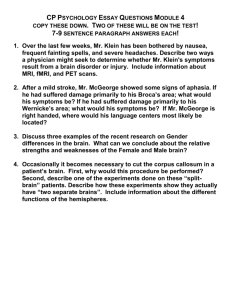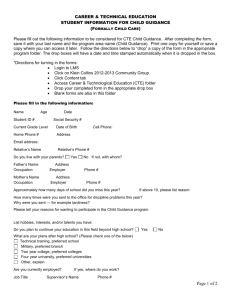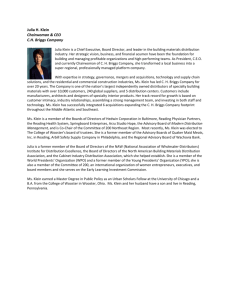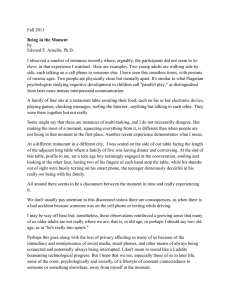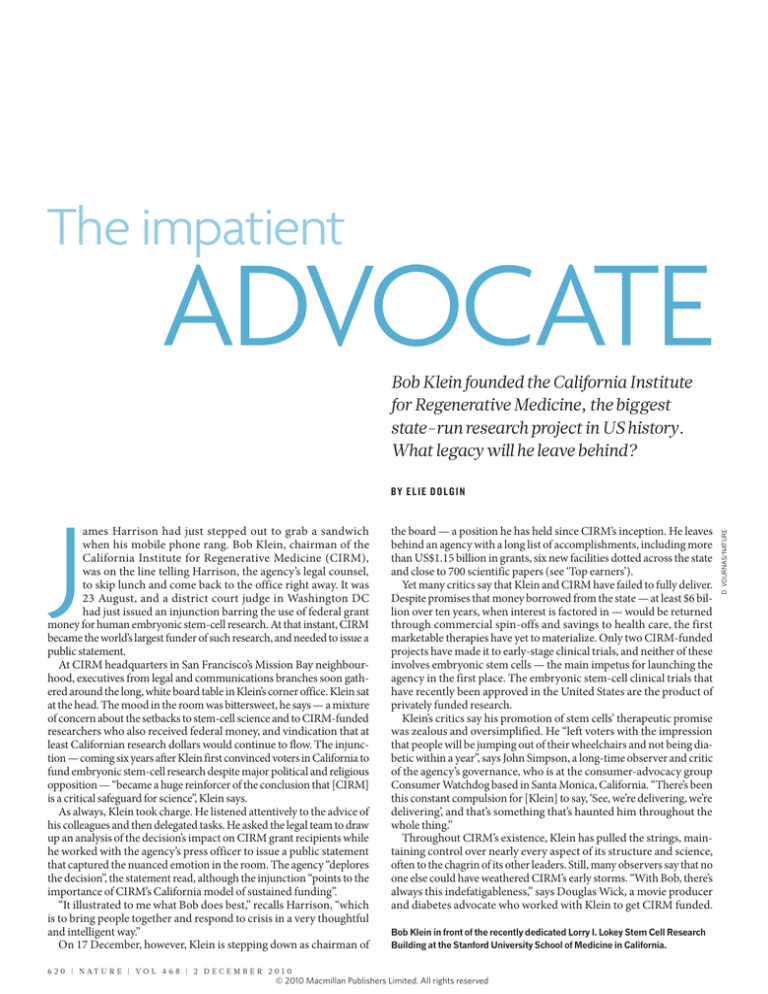
The impatient
ADVOCATE
Bob Klein founded the California Institute
for Regenerative Medicine, the biggest
state-run research project in US history.
What legacy will he leave behind?
J
ames Harrison had just stepped out to grab a sandwich
when his mobile phone rang. Bob Klein, chairman of the
California Institute for Regenerative Medicine (CIRM),
was on the line telling Harrison, the agency’s legal counsel,
to skip lunch and come back to the office right away. It was
23 August, and a district court judge in Washington DC
had just issued an injunction barring the use of federal grant
money for human embryonic stem-cell research. At that instant, CIRM
became the world’s largest funder of such research, and needed to issue a
public statement.
At CIRM headquarters in San Francisco’s Mission Bay neighbourhood, executives from legal and communications branches soon gathered around the long, white board table in Klein’s corner office. Klein sat
at the head. The mood in the room was bittersweet, he says — a mixture
of concern about the setbacks to stem-cell science and to CIRM-funded
researchers who also received federal money, and vindication that at
least Californian research dollars would continue to flow. The injunction — coming six years after Klein first convinced voters in California to
fund embryonic stem-cell research despite major political and religious
opposition — “became a huge reinforcer of the conclusion that [CIRM]
is a critical safeguard for science”, Klein says.
As always, Klein took charge. He listened attentively to the advice of
his colleagues and then delegated tasks. He asked the legal team to draw
up an analysis of the decision’s impact on CIRM grant recipients while
he worked with the agency’s press officer to issue a public statement
that captured the nuanced emotion in the room. The agency “deplores
the decision”, the statement read, although the injunction “points to the
importance of CIRM’s California model of sustained funding”.
“It illustrated to me what Bob does best,” recalls Harrison, “which
is to bring people together and respond to crisis in a very thoughtful
and intelligent way.”
On 17 December, however, Klein is stepping down as chairman of
6 2 0 | NAT U R E | VO L 4 6 8 | 2 D E C E m b E R 2 0 1 0
the board — a position he has held since CIRM’s inception. He leaves
behind an agency with a long list of accomplishments, including more
than US$1.15 billion in grants, six new facilities dotted across the state
and close to 700 scientific papers (see ‘Top earners’).
Yet many critics say that Klein and CIRM have failed to fully deliver.
Despite promises that money borrowed from the state — at least $6 billion over ten years, when interest is factored in — would be returned
through commercial spin-offs and savings to health care, the first
marketable therapies have yet to materialize. Only two CIRM-funded
projects have made it to early-stage clinical trials, and neither of these
involves embryonic stem cells — the main impetus for launching the
agency in the first place. The embryonic stem-cell clinical trials that
have recently been approved in the United States are the product of
privately funded research.
Klein’s critics say his promotion of stem cells’ therapeutic promise
was zealous and oversimplified. He “left voters with the impression
that people will be jumping out of their wheelchairs and not being diabetic within a year”, says John Simpson, a long-time observer and critic
of the agency’s governance, who is at the consumer-advocacy group
Consumer Watchdog based in Santa Monica, California. “There’s been
this constant compulsion for [Klein] to say, ‘See, we’re delivering, we’re
delivering’, and that’s something that’s haunted him throughout the
whole thing.”
Throughout CIRM’s existence, Klein has pulled the strings, maintaining control over nearly every aspect of its structure and science,
often to the chagrin of its other leaders. Still, many observers say that no
one else could have weathered CIRM’s early storms. “With Bob, there’s
always this indefatigableness,” says Douglas Wick, a movie producer
and diabetes advocate who worked with Klein to get CIRM funded.
Bob Klein in front of the recently dedicated Lorry I. Lokey Stem Cell Research
Building at the Stanford University School of Medicine in California.
© 2010 Macmillan Publishers Limited. All rights reserved
D. Vournas/nature
By EliE Dolgin
© 2010 Macmillan Publishers Limited. All rights reserved
News Feature
A
UC San Francisco
$110,532,518
L
I
The Three Families
TOP EARNERS
C
“His personal energy and charisma are so strong, and he has this
ability to get punched, stand up and go at it again.”
Klein was a Stanford-educated lawyer who had made millions in
real-estate development when, in September 2001, a week after the
terrorist attacks on the Twin Towers and the Pentagon, his youngest
son Jordan was diagnosed with type 1, or juvenile-onset, diabetes. Klein
was devastated. “It’s a life-changing shock when you know your child’s
life is in danger,” he says.
San Francisco
O
R
I
Stanford University
$175,862,473
N
A
6 2 2 | NAT U R E | VO L 4 6 8 | 2 D E C E m b E R 2 0 1 0
F
Klein wanted to speed the search for cures. “I thought, ‘we’ve got to
get some broader-based research funding’.” He soon approached the
Juvenile Diabetes Research Foundation International (JDRF) in New
York to ask how he could help. Klein had some political experience
from working with the state and with the national Democratic Party on
housing issues. And in 2002, he put it to use, leading the JDRF’s efforts
in lobbying Congress to pass a $1.5-billion federal funding measure to
support diabetes research. The experience of getting that bill approved,
Klein says, “demonstrated to me that dedicated, well-informed, focused
patient advocacy could be very effective”.
By that time, US President George W. Bush had imposed tough
restrictions on federal funding for human embryonic stem-cell research.
Convinced that such research offered the best hope for reversing his
son’s disease, Klein turned his attention to an idea then percolating in
California: that the state directly fund biomedical research that federal
money couldn’t support. “Getting a Bush override was not feasible,”
Klein recalls. “So the question then was: what can I do back home?”
Klein teamed up with several other affluent and politically savvy
parents of diabetic children — including movie director Jerry Zucker
and his wife Janet, and home developer Tom Coleman and his wife
Polly — and the ‘three families’, as they called themselves, together
with political consultants and lawyers, devised a ballot initiative that
would ask California taxpayers to support stem-cell science to the tune
of around $300 million per year for ten years.
The measure — which became known as the California Stem Cell
Research and Cures Bond Act of 2004, or simply Proposition 71 — did
not require approval or regular appropriations from the legislature.
Instead, the proposed initiative relied on long-term state-issued bonds,
effectively shielding the endowment from the whims of lawmakers.
Klein had experience in bond financing for housing development
and quickly took control of the campaign. He personally donated
around $1.2 million to get the initiative off the ground, later adding
another $3.1 million out of his pocket and raising $30 million more in
non-tax-deductable campaign contributions from others.
After a star-studded campaign endorsed by the likes of Brad Pitt, Christopher Reeve, Michael J. Fox and state governor Arnold Schwarzenegger,
the campaigners gathered at the Millennium Biltmore hotel in Los Angeles on
“i realiZeD
election night, in November 2004, to
ThaT KleiN
watch as the votes came in. The proposiWrOTe The
tion passed with 59% approval. That night,
iNiTiaTiVe
says Wick, “I remember saying to the celebratory gathering that if our daughter
FOr him TO
is cured of her diabetes, the person who
Be ChairmaN.
will be more responsible than any living
iT’s shameless
human will be Bob Klein”.
almOsT.”
But not all the early organizers of Proposition 71 remain enthusiastic about the
way Klein led the charge. “It became Bob’s show almost entirely, and
there was some friction about that,” recalls Peter Van Etten, former JDRF
president and chief executive. Coleman has not spoken to Klein since the
initiative passed, following disagreements over what Coleman viewed as
Klein’s self-promotional approach. Zucker remains on better terms with
Klein, but still feels some lingering resentment.
“If I had to do it over again I’d make the same call to Bob Klein because
I don’t think the rest of us would have got it done without him,” Zucker
The top five institutions funded
by the California Institute for
Regenerative Medicine (CIRM)
have received nearly half of its
US$1.15-billion research outlay.
Orange denotes those with major
CIRM facilities; blue, other
non-profit research and medical
institutions; green, for-profit
companies; and purple,
institutions given
‘bridge grants’ for
undergraduateand master’slevel training.
University of Southern California
$71,933,514
UC Los Angeles
$135,154,660
Los Angeles
UC San Diego
$77,177,593
San Diego
says. But, he adds, “what I was most unhappy about was the realization
after a while that [Klein] wrote the initiative for him to be the chairman.
That was something I was too naive to realize. It’s shameless almost.”
Under the terms of Proposition 71, the 29-member governing board
must include appointees with experience in academia, research, disease advocacy and biotechnology. The chair of the board, meanwhile,
must meet a laundry list of mandatory criteria. These include a history
of patient advocacy, leadership experience with a government agency,
legal experience passing medical legislation and a direct knowledge of
bond financing. Scientific expertise is not a requirement.
Sound familiar? “Look at the qualifications. They don’t fit a lot of
people,” notes board member David Serrano Sewell, a lawyer with the
San Francisco city attorney’s office.
Klein defends the job qualifications that he wrote into the statute.
“I wrote the job description based on what I thought would be the
challenges. I’m trained as a lawyer, so I’m going to think that legal is an
important criterion. I’m trained in finance, and I’m going to think that
finance during the projected period of economic distress for the state is
going to be very important. So I wrote those requirements in knowing
that if no one else could qualify, I could meet those. But someone had
to meet those criteria.”
Many people maintain that Klein was simply the best person for
the job. “He lived and breathed the mission,” says Jeannie Fontana,
executive director of patient advocacy at the Sanford-Burnham Medical Research Institute in La Jolla, California, who has often acted as
a stand-in on the CIRM board. Bernard Siegel, director of the nonprofit Genetics Policy Institute in Palm Beach Gardens, Florida, adds:
“He was able to blend in his passion with his networking skills, which
are formidable, with this knowledge of bonds. When you put all this
together he was able to create a state agency with unprecedented resilience that has been extraordinary successful.”
That resilience would be tested almost immediately after Proposition
71 passed. Critics of embryonic stem-cell science mounted legal challenges against the agency; as a result, bond sales were frozen until the
court cases were settled. Klein, thinking ahead, had written a workaround
into the bylaws. He was able to take out loans from elsewhere on the basis
© 2010 Macmillan Publishers Limited. All rights reserved
Feature News
that the bonds would eventually be paid — a little-known instrument
called a ‘bond anticipation note’. Buoyed by these and other loans from
the state’s general fund, Klein managed to keep administrative operations
going and fund the agency’s first training and research grants even before
the lawsuits were eventually thrown out, in May 2007.
In the first two years of legal and financial setbacks, the board was
struggling to find a president to lead the day-to-day operations of the
agency. Zach Hall, then an associate dean at the University of Southern California School of Medicine in Los Angeles, was brought in as an
interim president. He had the administrative chops, having previously
directed the US National Institute of Neurological Disorders and Stroke.
And as the lawsuits dragged on, Klein asked Hall to stay on full time.
Hall agreed. But it wasn’t long before he and Klein butted heads. One
of the main points of contention revolved around the agency’s scientific
strategic plan — a policy measure adopted in December 2006. Some
maintained that the president’s office alone should set the agency’s
scientific agenda, yet Klein made sure that he and several board members had a seat on the subcommittee that crafted the plan. As a result,
many people felt that the original strategic plan, as well as last year’s
update approved by Hall’s successor, the Australian assisted-reproduction pioneer Alan Trounson, focuses too heavily on clinical applications
at the expense of more fundamental basic science. For example, the
strategic plan allocates 16% of CIRM’s $2.4 billion projected research
budget to what it calls “innovation science”, exploratory open-ended
research, and more than half is allocated to “mission-directed science”,
which is focused on developing therapies.
Joel Adelson, a health-policy researcher at the University of California, San Francisco, who interviewed 17 of CIRM’s key stakeholders
and co-wrote an independent review of the agency earlier this year1,
says that Klein’s disagreements with Hall, and to a lesser extent with
Trounson, stemmed from Klein’s insistence on being involved in every
aspect of CIRM’s operations, including the scientific decisions.
“Klein has in effect acted like the chief operating officer beside
Trounson and beside Hall, and I can only say that this looks like it
must have been very uncomfortable for these guys,” Adelson says. “It’s
an unusual situation,” says Trounson. “And if you ask me what I prefer, I prefer the simple situation where the president is in charge of all
management and reporting to a board on policies. But it’s bifurcated,
and it was set up that way, so you don’t have a choice.” (Hall declined
to comment for this story.)
sTiCK TO The VisiON
Klein defends his march to the clinic as adhering to the vision he
presented to voters on the campaign trail. And although some basic
scientists take issue with CIRM’s funding allocations, most have come
to embrace the translational emphasis. For example, Jeanne Loring, a
CIRM-funded stem-cell researcher at the Scripps Research Institute
in La Jolla, says that Klein “has taken purely academic scientists who
didn’t give a damn about the clinical applications of their work, and
turned them into scientists who will now talk, without a trace of embarrassment, about the benefit of their research to patients”.
Patient advocates praise Klein as well. “He’s an historic figure with
real genius in terms of moving biomedicine forward,” says Jeff Sheehy,
a CIRM board member and director for communications at the University of California, San Francisco’s AIDS Research Institute. “He’s as
good as they get if not better.”
Developments in both science and politics have challenged CIRM’s
original rationale. In November 2007, researchers in Japan and Wisconsin reported that human skin cells could be coaxed in the laboratory to form embryonic-like pluripotent stem cells2,3 . This discovery
provided a new path to patient-specific stem cells
Nature.com
without the need for embryos. Then, a year and
For an interactive
a half later, US President Barack Obama issued
graphic of CIrM
an executive order widening the scope of federal
grant recipients see: funding for embryonic stem-cell research, easing
go.nature.com/38ew9w the need for state and private initiatives.
But Klein says CIRM’s mission goes beyond simply serving as a stopgap for embryonic stem-cell research during Bush-era restrictions, stressing that its focus on translational medicine distinguishes the California
agency from the National Institutes of Health (NIH). For instance, he
points to the disease team grants, launched last year, that require recipients to have a strategy for landing an investigational new drug application
within four years.
“The purpose of CIRM is not science for science’s sake,” Klein says.
“The purpose of CIRM is medical science with a plan to drive that science
all the way through to therapies.”
Marie Csete, a former chief scientific
“KleiN is aN
officer at CIRM, says that Klein embraced
hisTOriC FiGUre the new ‘induced pluripotent’ stem cells.
WiTh real
“There was a transient moment where
GeNiUs iN Terms hanging on to embryonic stem cells was
important, but he very quickly grasped
OF mOViNG
that they were only one tool in the toolBiOmeDiCiNe
box of regenerative medicine,” she says.
FOrWarD.”
After dedicating nine years and millions of dollars to the agency, Klein says
it’s time to step aside and focus on family issues — his son is still battling
diabetes, he lost his mother to Alzheimer’s disease last year and his wife
is currently undergoing chemotherapy for breast cancer. Agency insiders
are sad to see him go. “The joke is to clone Bob Klein,” says Lynn Harwell,
CIRM’s deputy to the chair for finance, policy and outreach. She pauses
before quickly adding: “Although of course we don’t condone cloning.”
Geoffrey Lomax, CIRM’s senior officer for medical and ethical standards, commends Klein’s many accomplishments, but thinks that fresh
leadership might help to clarify boundaries between the board and the
staff. “As Mr Prop 71, Bob’s relationship to the organization is unique,”
Lomax says. “I would suspect that there might be cleaner lines with someone coming in who doesn’t bring that intimacy with the proposition.”
Depending on who replaces him — nominations were made earlier
this week by state officials including Schwarzenegger, and the new chair
will be elected by the board on 15 December — Klein’s departure might
also trigger the president to leave, thereby causing a complete overhaul of
CIRM’s leadership. Trounson says he told Schwarzenegger that he would
like that next chairperson to be “somebody who’s in the delivery end of
the spectrum — that is, somebody who has worked with the biotech or
pharmaceutical industry”.
But as this issue was going to press, the leading internal candidate to
replace Klein, many say, is vice-chair Art Torres, a former state senator
and chairman of the California Democratic Party. Torres and Trounson
reportedly cannot stand each other. Trounson notes that Torres is “a politician, so he’s in that end of the spectrum”. Torres, for his part, declined
to comment on his relationship with the president.
Whoever takes the reins will continue to deal with the fallout from
the federal injunction. But Klein leaves the agency in strong legal and
scientific positions, with several projects — including a few that rely on
embryonic stem cells — likely to enter early clinical development in the
next few years.
Gerald Levey, an ex-board member and former dean of the David
Geffen School of Medicine at the University of California, Los Angeles,
says that Klein’s record at CIRM stands for itself. “If he did nothing else
with his life, he did a wonderful thing.”
But Klein vows to return to the agency’s service in 2014 to help CIRM
secure another $3 billion commitment from California’s taxpayers. “I
have four years to put my life back into a position where I can commit
myself to another campaign,” says Klein. He has no plans to retire or stop
the search for a cure for his son’s diabetes: “You’re either learning and
growing or you’re dying, and I want to continue to learn and grow.” ■
Elie Dolgin is a news editor with Nature Medicine in New York.
1. adelson, J. W. & Weinberg, J. K. Am. J. Public Health 100, 446–451 (2010).
2. takahashi, K. et al. Cell 131, 861–872 (2007).
3. Yu, J. et al. Science 318, 1917–1920 (2007).
2 D E C E m b E R 2 0 1 0 | VO L 4 6 8 | NAT U R E | 6 2 3
© 2010 Macmillan Publishers Limited. All rights reserved

